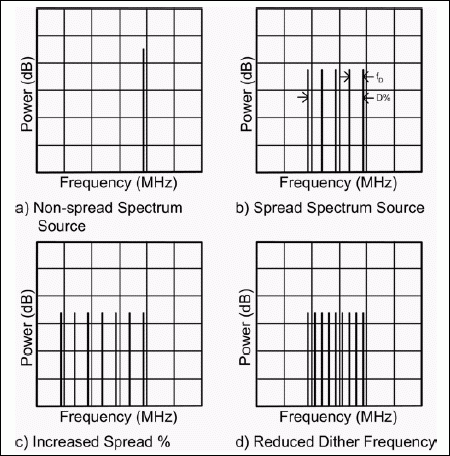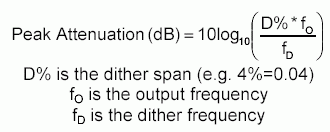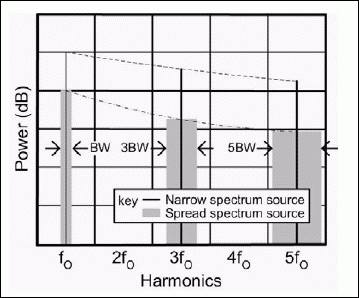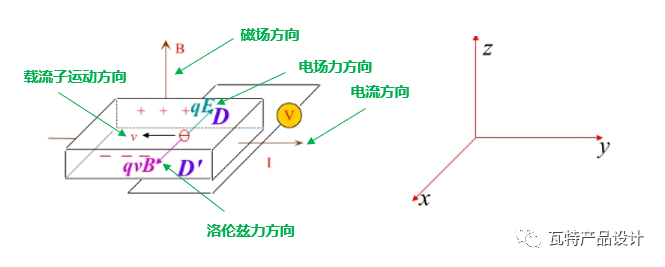Introduction
The DS1086L is a 3.3V spread-spectrum oscillator that is used in applications concerned about complying with electromagnetic compatibility (EMC) standards such as FCC part 15 or CISPR 22. The output of the DS1086L is a 50% duty cycle square wave that is frequency modulated by a triangle wave to produce a flat wide-band spectrum with lower peak power levels.Ideally with this architecture the peak power attenuation is always proportional too the dither span and the ratio of the output frequency to the dither frequency. This application note discusses the practical limits for these parameters incurred due to the way power spectrums are measured.
Dither Span and Frequency in the Power Spectrum
Modulating a square wave's frequency with a triangle wave creates a bandwidth composed of individual spectral lines about the fundamental frequency. The modulation frequency (fD) determines the spacing of the spectral lines (see Figure 1b), and the dither span (D%) determines the bandwidth of the signal about the fundamental frequency. Figure 1 shows all the additional spectral lines below the original output frequency, which is consistent with the downmodulation scheme of the DS1086L.

Figure 1. Spectral components of non-dithered and dithered oscillators.
The peak power attenuation seen in the power spectrum of a dithered oscillator is derived from the fact that both the dithered and undithered oscillators deliver the same amount of power into a given load. An undithered oscillator (Figure 1a) delivers all the signal power at one frequency. The dithered signal's (Figure 1b) power is delivered via multiple spectral lines with a lower power level for each individual spectral line. Both increasing the dither percentage (Figure 1c) and reducing the dither frequency (Figure 1d) increase the number of spectral lines, which reduces the power of any one spectral line.
A formula for calculating the expected peak power attenuation versus a narrow band source is given by:

This formula is only accurate when the dither frequency is high enough that there is only one spectral line per measurement bandwidth. This phenomenon is described below and illustrated by Figure 2.

Figure 2. The ideal dither frequency and the effects of dithering at lower frequencies.
The Effects of Measurement Bandwidth
The resolution bandwidth is the bandwidth of the filter used for a single measurement point that is displayed on the screen of a spectrum analyzer. It is generally a bandpass filter after the mixer on an analyzer, and it is used to select the range of frequencies that will be presented to the detector. Selecting a narrower bandwidth improves the analyzer's ability to discern neighboring frequencies.The resolution bandwidth used during measurements on spread-spectrum oscillators has a profound effect on the levels measured for two reasons. The first reason is the resolution bandwidth used for a measurement determines what is narrow-band and what is a wide-band signal. If a signal that has a 100Hz bandwidth and its frequency is within the range of a 1kHz bandpass filter, the analyzer can easily detect the power level of the entire signal by taking one measurement. This makes the 100Hz signal narrow band with respect to the analyzer's current settings. If the signal's bandwidth becomes 10kHz while retaining the same power level, the analyzer will read only a portion of the power per measurement because the entire signal cannot be measured within one resolution bandwidth. Thus, the DS1086L dither percentage should be set high enough that the signal being measured is wider than the resolution bandwidth or no EMI improvement will be measured because the signal is perceived as narrow band. The EMI will be attenuated versus the non-dithered signal, but it will not measure as such, which is important when trying to comply with EMC standards.
The second relationship between the resolution bandwidth and the dither is that the dither frequency must be greater than the resolution bandwidth if lowering the dither frequency is expected to increase the attenuation. This condition is true because when multiple spectral lines exist within one measurement bandwidth, the power from all the spectral lines within the measurement bandwidth will add to produce the same power as one spectral line within the bandwidth (Figure 2). Thus once the dither frequency is below the resolution bandwidth, there is no longer any attenuation benefit to be gained by further reducing the dither frequency as identified by the attenuation formula. It should be noted that this statement is not intended to imply that the dither frequency should not be lower than the resolution bandwidth.
Often, the measurement bandwidths of concern are those required to meet the FCC part 15 class B standard. Part 15 requires that frequencies below 30MHz are detected with a 9kHz measurement bandwidth and frequencies between 30MHz and 1GHz are measured using a 120kHz measurement bandwidth. The dither frequency of the DS1086L is between 4.1kHz and 32.5kHz depending on the dither rate setting and the master oscillator frequency. For measurements above 30MHz, there are always multiple spectral lines per measurements, so there is no obvious benefit to using any particular dither frequency setting. The lower dither frequency settings still have a non obvious benefit that they reduce the slight peaks caused by internal bandwidth limitations that can be seen at the edges of the spread-spectrum bandwidth. For frequencies below 30MHz, the lowering the dither frequency provides more attenuation until the dither frequency is below the 9kHz measurement bandwidth.
The Effect of Spread-Spectrum Oscillators on Harmonics Measurements
A sine wave appears in the frequency domain as a single spectral line (delta function) with an amplitude equal to the power of the signal. A square wave with the same frequency has a fundamental frequency component that appears at the same frequency as the corresponding sin wave, but the amplitude is only 64% of the square wave's power. The remainder of the power is spread out at the odd harmonics with a 1/n amplitude roll off, where n is the nth odd harmonic.Spread-spectrum oscillators can see an additional benefit related to measured harmonic content. The bandwidth of the odd harmonics of a frequency modulated square wave is equal to harmonic number times the bandwidth of the square wave at the fundamental frequency (see Figure 3). The wider bandwidth is a result of the separation of the spectral lines, which reduces the number of spectral lines per measurement bandwidth. This phenomenon is particularly important when the examining the oscillator using the 120kHz FCC measurement bandwidth. As mentioned before, there are always multiple spectral lines with the DS1086L near the fundamental frequency when using the 120kHz measurement bandwidth, but as the spectral lines separate at the harmonics, the peak power is reduced beyond the 1/n reduction. The harmonic roll off is approximately 1/n3/2 until the spectral lines separate far enough that there is only one spectral line per measurement bandwidth.

Figure 3. Spectral content for dithered oscillator harmonics.
The reason that a non-dithered signal, such as a low jitter crystal oscillator, does not benefit from the widening bandwidth phenomenon is that the bandwidth is much narrower than the measurement bandwidth to begin with. When looking at the 3rd or 5th harmonic, the 3x or 5x signal bandwidth is still narrow band compared to the 120kHz measurement bandwidth so all the energy is still being detected within one measurement.
 電子發燒友App
電子發燒友App






































評論